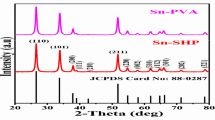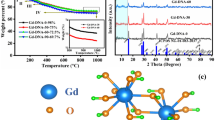Abstract
For the first time, Nd-MOF nanostructures were synthesized using a novel ultrasonic procedure. The final products were characterized by relevant techniques of X-ray diffraction, scanning electron microscopy, thermogravimetric analysis, differential scanning calorimetry, Fourier-transform infrared spectroscopy, energy-dispersive X-ray mapping analysis, nuclear magnetic resonance, vibrating sample magnetometer, photoluminescence, and Brunauer–Emmett–Teller (BET) surface area analysis. Results showed that using ultrasonic irradiation can produce Nd-MOF samples with desirable physicochemical properties. It was found that the Nd-sample synthesized in optimum conditions has a high surface area of 1649 m2 g−1. This value expands the application of these novel materials in different fields such as electrochemical applications. The electrochemical cyclic voltammetry method was employed to study the behavior of DA on the proposed modified electrode. The results revealed high yields of these compounds in the electrooxidation of dopamine. The efficient synthesis route, novel physichochemical properties, and potential electrochemical applications developed in this study can be used as a novel protocol for other MOFs.
Graphic abstract




















Similar content being viewed by others
References
Petkov TI, Barzev KN (1987) Some aspects of hydrogen application as a supplementary fuel to the fuel-air mixture for internal combustion engines. Int J Hydro Energy 12(9):633–638
Rosi NL, Eckert J, Eddaoudi M, Vodak DT, Kim J, O’keeffe M, Yaghi OM (2003) Hydrogen storage in microporous metal-organic frameworks. Science 300(5622):1127–1129
Murray LJ, Dinca M, Long JR (2009) Hydrogen storage in metal–organic frameworks. Chem Soc Rev 38(5):1294–1314
Eddaoudi M, Belmabkhout Y, Pillai RS, Alezi D, Shekhah O, Bhatt P, Chen Z, Vaesen S, De Weireld G, Pang M (2017) Metal-organic frameworks to satisfy gas upgrading demands: fine-tuning the soc-MOF platform for the operative removal of H2S. J Mater Chem A 5(7):3293–3303
Lee JeongYong, Farha OK, Roberts J, Scheidt KA, Nguyen ST, Hupp JT (2009) Metal–organic framework materials as catalysts. Chem Soc Rev 38(5):1450–1459
Kreno LE, Leong K, Farha OK, Allendorf M, Van Duyne RP, Hupp JT (2011) Metal–organic framework materials as chemical sensors. Chem Rev 112(2):1105–1125
Li H, Eddaoudi M, O’Keeffe M, Yaghi OM (1999) Design and synthesis of an exceptionally stable and highly porous metal-organic framework. Nature 402(6759):276
James SL (2003) Metal-organic frameworks. Chem Soc Rev 32(5):276–288
Furukawa H, Cordova KE, O’Keeffe M, Yaghi OM (2013) The chemistry and applications of metal-organic frameworks. Science 341(6149):1230444
Murray LJ, Dincă M, Long JR (2009) Hydrogen storage in metal–organic frameworks. Chem Soc Rev 38(5):1294–1314
Wang C, Wang Z, Gu F, Guo G (2011) Three novel lanthanide MOFs constructed from 1,3-benzenedicarboxylic acid and 1,10-phenanthroline: hydrothermal synthesis, crystal structure and thermal properties. J Mol Struct 1004(1–3):39–44
Ilango E, Rajasekaran R, Shankar K, Krishnan S, Chithambaram V (2014) Synthesis, growth and characterization of non linear optical Bisthiourea ammonium chloride single crystals by slow evaporation technique. Opt Mater 37:666–670
Chen Y, Ni D, Yang X, Liu C, Cai K (2018) Microwave-assisted synthesis of honeycomblike hierarchical spherical Zn-doped Ni-MOF as a high-performance battery-type supercapacitor electrode material. Electrochimica Acta 278:114–123
Nasiri Azad F, Ghaedi M, Dashtian K, Hajati S, Pezeshkpour V (2016) Ultrasonically assisted hydrothermal synthesis of activated carbon–HKUST-1-MOF hybrid for efficient simultaneous ultrasound-assisted removal of ternary organic dyes and antibacterial investigation: Taguchi optimization. Ultrason Sonochem 31:383–393
Naderi M (2015) Surface area: Brunauer–Emmett–Teller (BET). Progress in filtration and separation. Elsevier, New York, pp 585–608
Shokhchashm Z et al (2019) Synthesis and crystal structure of [Pb (gly) 2] n; new lead (II) coordination polymer with glycine ligand. J Nanostruct 9(1):8–13
Song Y et al (2016) Lanthanide-Coordination Polymers with Pyridinedicarboxylic Acids: Syntheses, Structures, and Luminescent Properties. Zeitschrift für anorganische und allgemeine Chemie 642(11–12):681–691
Author information
Authors and Affiliations
Corresponding author
Additional information
Publisher's Note
Springer Nature remains neutral with regard to jurisdictional claims in published maps and institutional affiliations.
Rights and permissions
About this article
Cite this article
Bakhshi, A., Saravani, H., Sargazi, G. et al. Ultrasound-assisted efficient synthesis of a novel Nd–MOF polymer as a new candidate for electrocatalytic activity in hydrogen storage. J Appl Electrochem 51, 399–410 (2021). https://doi.org/10.1007/s10800-020-01504-2
Received:
Accepted:
Published:
Issue Date:
DOI: https://doi.org/10.1007/s10800-020-01504-2




